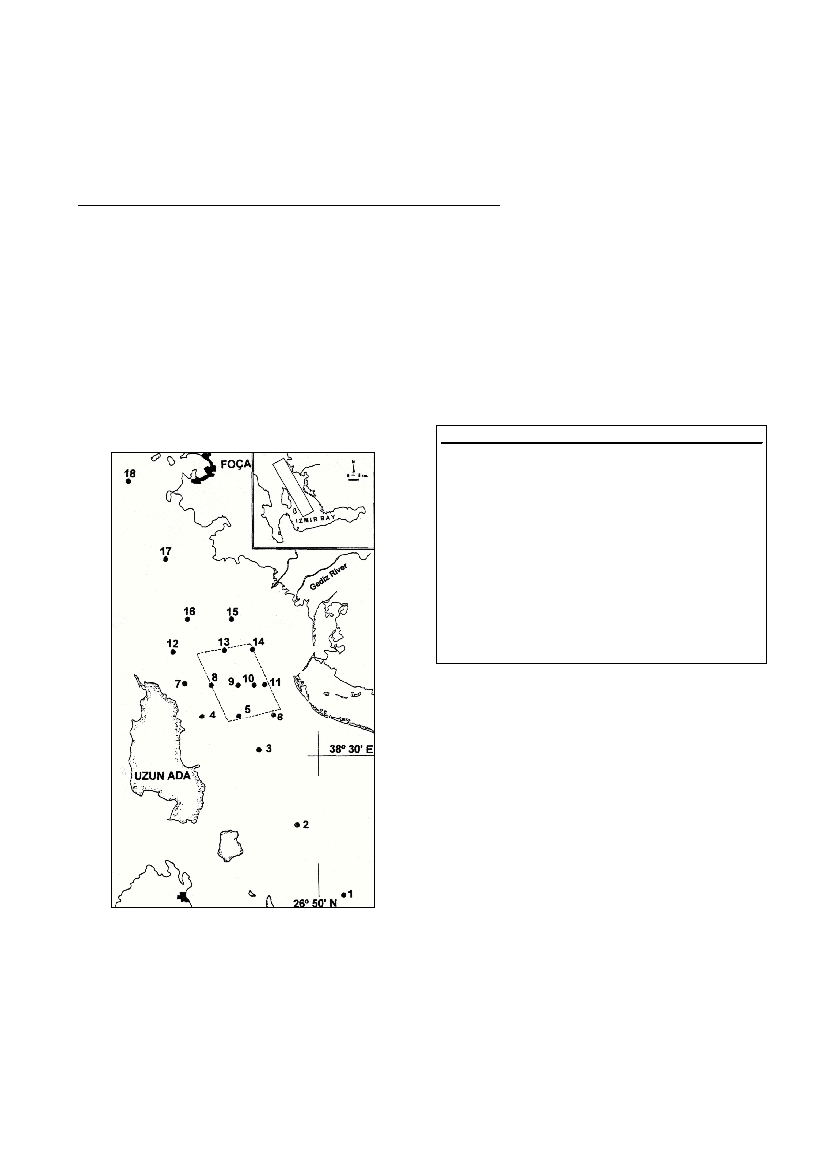Rapp. Comm. int. Mer Médit., 36,2001
374
Introduction
Intense sedimentations occurred in Izmir harbour lessened water depth
and resulted in hindering the ships to approach to the harbour. Because of
the huge economical losses it occasionally become a requisite to deeper the
approaching route of the ship by dredging.
The mud-dredging efforts were carried out near the harbour in the two
periods; 1930-1976 (ca. 2.8 million m
3
of sediment off Göztepe-inner bay)
and 1976-1988 (9 million m
3
of sediment off Hekim Ada-outer bay).
Considering the unpredictable bad effects of the dumping efforts on the
ecosystems it was planned to alter the dumping area. Finally the area in the
northeast of Uzun Ada (outer bay) had been suggested for this purpose.
In the present paper it is intended to elucidate the status of the zooben-
thic fauna in the probable dumping area to constitute a database for the
monitoring program.
Material and methods
Benthic samples were taken by a Van Veen Grap in 18 stations in June
1992 (Fig 1). The samples were washed through sieve with 1 mm mesh
size. The community indices were applied on the presence-absence and
abundance data.
Fig 1. Map of the investigated area with location of sampling sites.
Results and discussion
A total of 74 species and 714 individuals belonging Nemertea,
Sipuncula, Polychaeta, Crustacea, Phoronida, Mollusca and Echinoder-
mata were determined, of which Pseudopolydora antennataand Aricidea
mutabiliswere new records for the Turkish fauna.
The most diversified group was Polychaeta with 43 species and 339 ind.
(47.4%) followed by Crustacea with 13 species and 126 ind (17.7%) and
Echinodermata with 8 species and 108 ind. (15.3%).
The most dominant species of the important groups and their relative
dominance values are as follows; Polychaeta (Sternaspis scutata, 5.6%;
Terebellides stroemi, 4%; Prionospio fallax, 2.9% and Lumbrineris latreil-
lii, 2.7%); Crustacea (Ampelisca sp., 2.9%; Apseudes latreillei, 2.5%;
M
i
c
rodeutopus sp., 2.5% and Athanas nitescens, 1.6%); Mollusca
(Turritella communis, 5.4%; Corbula gibba, 3.7% and Clausinella fascia-
ta) and Echinodermata (Labidoplax digitata, 5.6%; Amphiura filiformis,
3.8%; Trachythyone tergestina, 1.9% and Brissopsis lyrifera, 1.6%).
The community diversity (H’) and evenness (J’) indices in each site
were very high (Table 1). The lowest H’value (3.66) was calculated in the
station 2 where S. scutatawas represented by high number of specimens.
The species with C. gibbaand Ia were preferential species of the sandy-
mud substratum of Izmir Bay.
Table 1. Depths, community indices and dominant species of each
sampling site.
In the area 13 species were categorized as constant, 24 as common and
37 as rare.S. scutata, T. communis, C. gibbaand L. digitatacomprised the
highest values with 100%. The finding of the constant species, P. malm-
greniwas noteworthy since it has widely been utilised as an indicator
species of the organically polluted bottom. However in the sampling peri-
od it formed a scarce population as compared to that in the polluted waters.
The Cluster analysis depicted that the faunal affinities in the area were
relatively high. The highest similarity was calculated between the stations
17 and 18 (67%) which were far from the probable dumping area. The sta-
tions such as 9, 10, 11, 14 and 15 which were under the in?uence of the
Gediz River constituted a group of 45% similarity.
The former sludge dumping area was investigated by Kocatas et al.(1)
who emphasized that the dumping activities caused less effects on the ben-
thic biota with only one opportunistic species (Audouinia tentaculata).
They also emphasized the dominance of C. gibbain the area. In this study
solely P. malmgrenias being opportunistic species was found with low
dominance but high frequency index values. The other species collected in
the area are widely distributed in the undisturbed soft substratum of the
Mediterranean Sea (2). In conclusion it could be pointed out that the prob-
able dumping area was typical of sandy- mud biocenosis with a few oppor-
tunistic components.
References
1 – Kocatas A., Ergen Z. and Katagan T., 1992. The effects of the sludge
dumping and disposal on the benthic fauna in Izmir Bay.Rapp. Comm. int.
Mer Médit., 33.
2 – Ergen Z., Cinar M.E. and Ünsal M., 1998. Polychaetes from the Manavgat
River Delta (Turkish Mediterranean coast). Rapp. Comm. int. Mer Médit., 35:
536-537.
ZOOBENTHOS OF THE PROBABLE DUMPING AREA IN IZMIR BAY (AEGEAN SEA)
Melih Ertan Çinar, Zeki Ergen*, Ahmet Kocatas and Tuncer Katagan
Ege University, Faculty of Fisheries, Dept. of Hydrobiology, Izmir,Turkey - cinar@sufak.ege.edu.tr
Abstract
The samples were collected at 18 stations in June 1992. A total of 74 species were recorded, of which Pseudopolydora antennataand
Aricidea mutabiliswere new to the Turkish fauna. The most dominant and frequent species in the area were Sternaspis scutata,Turritella
communis, Corbula gibbaand Labidoplax digitata.As a results it can be conclude that the study area possess typical muddy bottom fauna
of the Mediterranean Sea.
Key-words: zoobenthos, monitoring, pollution, Aegean Sea, Eastern Mediterranean.
StationDepthSNH’J’Dominant Species
148 m27384.620.97
Terebellides stroemi
(5.3%)
252 m16273.660.91
Sternaspis scutata
(25.9%)
348 m21304.250.97
Turritella communis
(13.3%)
451 m28414.690.98
Magelona papillicornis
(7.3%)
551 m28444.690.98
S. scutata
(6.8%)
632 m24474.230.92
Lumbrineris latreillii
(19.1%)
758 m20344.190.97
Labidoplax digitata
(11.8%)
855 m17403.770.92
Microdeutopus sp.
(17.5%)
945 m24444.320.94
L. digitata
(%9.1)
1035 m26394.610.98
Phascolosoma sp.
(7.7%)
1120 m28604.600.96
L. latreillii
(8.3%)
1259 m29474.640.95
Clausinella fasciata
(8.5%)
1345 m17313.950.97
Microdeutopus sp.
(12.9%)
1419 m23384.390.97
Nephthys hombergi
(10.5%)
1536 m25384.430.95
Chaetozone sp.
(10.5%)
1656 m26404.440.97
Microdeutopus sp.
(12.5%)
1752 m22424.210.94
S.scutata
(11.9%)

